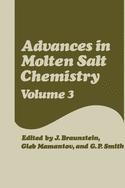Description
Advances in Molten Salt Chemistry, Softcover reprint of the original 1st ed. 1975
Volume 3
Authors: Braunstein J., Mamantov Gleb, Smith G. P.
Language: English
Subject for Advances in Molten Salt Chemistry:
Approximative price 52.74 €
In Print (Delivery period: 15 days).
Add to cart
Publication date: 01-2012
469 p. · 15.2x22.9 cm · Paperback
469 p. · 15.2x22.9 cm · Paperback
Description
/li>Contents
/li>
The first chapter of this volume deals with computer simulation of molten salt behavior by molecular dynamics calculations. The next four chapters are reviews of experimental work: Chapter 2 deals with the solubility of nonre active gases in molten salts, Chapter 3 with various types of organic reactions in molten tetrachloroaluminates, Chapter 4 with techniques for the study of molten fluorides, and Chapter 5 with the physical and chemical properties of thiocyanate melts. The last chapter is a collection of phase diagrams for binary and ternary fluoride systems. J. B., G. M., G. P. S. v CONTENTS Chapter 1 MOLECULAR DYNAMICS CALCULATIONS ON MOLTEN IONIC SALTS L. V. Woodcock 1. Introduction. . 4 2. Intermolecular Forces in Molten Salts 4 2.1. True and Effective Pair Potentials 2.2. Semiempirical Models 6 3. Computational Techniques 13 3.1. Molecular Dynamics Simulation 13 3.2. The Monte Carlo Method 15 3.3. Electrostatic Summations . . 18 4. Calculation of Physical Properties 23 4.1. Equilibrium Properties . 23 4.2. Transport Coefficients 27 4.3. Spectroscopic Properties 32 5. Applications. . . . . . . . 35 5.1. Studies of Interionic Forces. 35 5.2. Microstructure and Mechanisms 40 5.3. Interpretation of Experimental Observables 50 5.4. Reappraisal of Molten Salt Theories . 64 70 6. Conclusions 7. References. 72 vii Contents viii Chapter 2 GAS SOLUBILITY IN MOLTEN SALTS P. Field 1. Introduction 75 2. Experimental Techniques 78 3. Solution Thermodynamics.
1 Molecular Dynamics Calculations on Molten Ionic Salts.- 1. Introduction.- 2. Intermolecular Forces in Molten Salts.- 2.1. True and Effective Pair Potentials.- 2.2. Semiempirical Models.- 3. Computational Techniques.- 3.1. Molecular Dynamics Simulation.- 3.2. The Monte Carlo Method.- 3.3. Electrostatic Summations.- 4. Calculation of Physical Properties.- 4.1. Equilibrium Properties.- 4.2. Transport Coefficients.- 4.3. Spectroscopic Properties.- 5. Applications.- 5.1. Studies of Interionic Forces.- 5.2. Microstructure and Mechanisms.- 5.3. Interpretation of Experimental Observables.- 5.4. Reappraisal of Molten Salt Theories.- 6. Conclusions.- 7. References.- 2 Gas Solubility in Molten Salts.- 1. Introduction.- 2. Experimental Techniques.- 3. Solution Thermodynamics.- 3.1. Solubility.- 3.2. Heats of Solution.- 3.3. Entropy of Solution.- 4. Calculation Methods.- 4.1. Microscopic Model.- 4.2. Macroscopic Model.- 4.3. Comparison of the Methods.- 5. Appendix.- 6. References.- 3 Organic Reactions in Molten Tetrachloroaluminate Solvents.- 1. Introduction.- 2. Condensation-Addition Reactions.- 3. Dehydrogenation-Condensation Reactions.- 4. Molecular Rearrangements and Isomerizations.- 5. Miscellaneous Reactions.- 5.1. Dehydration Reactions.- 5.2. Exchange Reactions.- 5.3. Reduction and Chlorination Reactions.- 6. Organic Electrode Reactions.- 7. References.- 4 Experimental Techniques in Molten Fluoride Chemistry.- 1. Introduction.- 2. Thermochemistry of the Containment and Purification of Molten Fluorides.- 3. Handling Fluorides.- 3.1. Safety and Purity Aspects.- 3.2. Vapor Pressure of Molten Fluorides; the Distillation of BeF2.- 4. Analysis.- 5. Design of Equipment.- 5.1. Containers and Accessories.- 5.2. Connections and Filters.- 5.3. Thermocouple Wells.- 5.4. Valves and Gas Flow Controls.- 5.5. Devices for Sampling Molten Fluorides and for Adding Reagents in Controlled Atmospheres.- 6. Absorption Spectroscopy of Molten Fluoride Solutions.- 6.1. Visible and Ultraviolet Spectroscopy.- 6.2. Infrared and Raman Spectroscopy.- 7. Electrochemistry of Molten Fluoride Solutions.- 7.1. General Aspects and Electrical Insulators.- 7.2. Potentiometric Measurements.- 7.3. Voltammetric and Related Electroanalytical Methods.- 7.4. Electrical Conductivity Measurements of Molten Fluorides.- 8. Miscellaneous Measurements.- 8.1. Determination of Equilibrium Phase Diagrams of Fluoride Systems.- 8.2. Viscosity and Density Measurements of Molten Fluorides.- 8.3. Determination of the Surface Tension of Molten Fluorides.- 9. Presentation of Data of Equilibria in Molten Halides.- 10. Conclusions.- 11. References.- 5 The Chemistry of Thiocyanate Melts.- 1. Introduction.- 1.1. Versatility of Thiocyanates.- 1.2. Melting Points and Availability.- 1.3. Thiocyanate as Ligand.- 1.4. Physical Properties.- 1.5. Thermal Stability of Thiocyanates.- 1.6. Electrochemical Stability of Molten Thiocyanate.- 2. Chemistry of the Main Group Elements.- 2.1. Complexes with Alkaline Earth Cations.- 2.2. Indium and Thallium Cations.- 2.3. Reactions with Organic Compounds.- 2.4. Reactions with Tin and Lead Compounds.- 2.5. Reactions with Nitrogen, Antimony, and Bismuth Compounds.- 2.6. Reactions with Oxygen and Sulfur Compounds.- 2.7. Reactions with Halogen Compounds.- 3. Chemistry of the Transition Metals.- 3.1. Reactions with Compounds of Vanadium.- 3.2. Reactions with Compounds of Chromium and Molybdenum.- 3.3. Reactions with Compounds of Manganese and Rhenium..- 3.4. Reactions with Compounds of Iron.- 3.5. Reactions with Compounds of Cobalt.- 3.6. Reactions with Compounds of Nickel and Platinum.- 3.7. Reactions with Compounds of Copper, Silver, and Gold.- 3.8. Reactions with Compounds of Zinc, Cadmium, and Mercury.- 4. Chemistry of the “F” Block Elements.- 5. Conclusion.- 6. References.- 6 Phase Diagrams of Binary and Ternary Fluoride Systems.- 1. Introduction.- 2. Binary Systems.- 3. Ternary Systems.
© 2024 LAVOISIER S.A.S.




